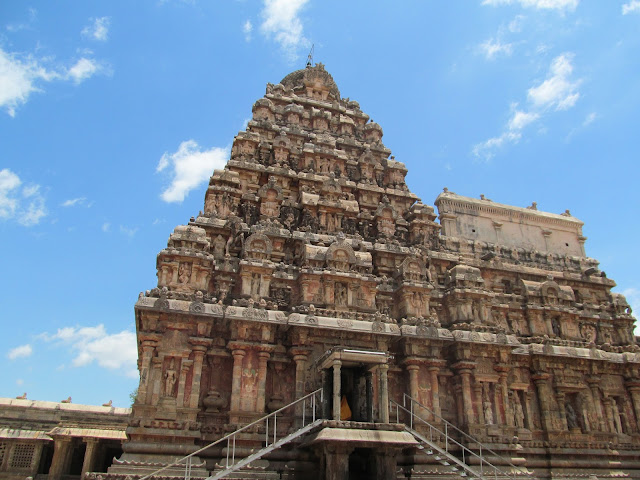In the many tours I've had and the wonderful places I've visited, visiting the Airavatesvara Temple in Darasuram is an experience I'll never forget. Built by Rajaraja Chola II in the 12th Century C.E., the temple is not as enormous as the other Great Living Chola temples- the mandapa is rather small in size. But what will surely take your breath away is the delicate features & attention to detail in the statues and figures around the temple.
The Legend behind the temple goes thus: Airavata, while suffering from a change of colour curse from Sage Durvasa, had its colours restored by bathing in the sacred waters of this temple. This legend is commemorated by an image of Airavata with Indra seated in an inner shrine. The temple and the presiding deity derive its name from this incident. Another legend goes that the King of Death, Yama also worshipped Shiva here. Tradition has it Yama, who was suffering under a Rishi's curse to form a burning sensation all over the body, was cured by the presiding deity Airavatesvarar. Yama took bath in the sacred tank and got rid of the burning sensation. Since then the tank has been known as Yamateertham.
 |
| The Entrance to the temple. Photo: Authour |
When I reached Darasuram, I wasn't expecting much. The outer walls of the temple do not have much stonework on them, The statues of small Nandis (the mount of Lord Shiva), were the only affluence afforded on the walls.
 |
| The statues of Nandi on the boundary Walls. Photo credits: Wikimedia. |
The beauty that lies inside is given a hint in the ridiculously detailed
Mahadwara (main entrance) int the east side through which we enter the temple. As we step into the temple we are greeted by the grand sight of delicately carved statues on the rooftop, as well as on the pillars. Malaylees would be instantly able to represent the small Kodimaram.
 |
| The view as you enter; Photo; Author |
I cannot possibly explain the beauty of the temple itself; I leave it to the photos I've attached, as well as the 360 degree view of the temple.
The Temple was built rather late into the Chera Empire's reign; by 1279, (i.e., within 100 years of its construction) the Chera Empire was subsumed by the Pandyas. Which makes this temple truly a wonder- it was not built in the best of times, but it exemplifies the epitome of Chola architecture and is rightly considered as a "Great Living Chola Temple", a UNESCO World Heritage.
 |
| The Famous Chariot; One can only wonder the quality & workmanship of these artisans.Photo Author. |
My interest in these temples were piqued by my visit to them, and it opened a door of history about the Cholas that I was generally ignorant or dismissive. I would advice anyone even slightly interested in History to visit these places (Brihedesavar Temple, Darasuram Airatasevara Temple) to be transported to times past, to the glorious past of the Cholas.
I would think it to be my duty to add all photos I have of this beautiful temple, and I have attached it below.
I thought of ending this series at this, a personal experience of Darasuram, but while researching for this article and the others, (and partly motivated by my thinking of the problems of imposing Western Historiography on Indian History and my addiction to Crusader Kings II), my next article in this series will be on Royal titles used by the Cholas.
 |
| Another View of the Chariot, note that there are sculptures below the Horse's belly,like the sculptors wanted to fit in more. Photo: Author |
 |
| Yet another view of the Chariot. |
 |
| The Elephants hailing one's entry into the temple. |
 |
| The View of the raised platform |
 |
| Sculptures on the mandapa; the Ornate nature is visible . Photo: Aiuthor |
 |
| A View of the main temple. Photo: Authour |
 |
| A Coronation (possibly) of Rajaraja Chola II, the Emperor who built the temple.
|
 |
| The Main temple, a closer view
|
 |
Thank you for your patience; Lord Vishnu (?)
Additional Notes
C.E: Common Era.
References
"The Ocean of Churn:How the Indian Ocean shaped Human History", Sanjeev Sanyal, Penguin Random House, 2016
" A History of South India", KA Nilakanta Sastri, Oxford University Press, 1975
|




















No comments:
Post a Comment